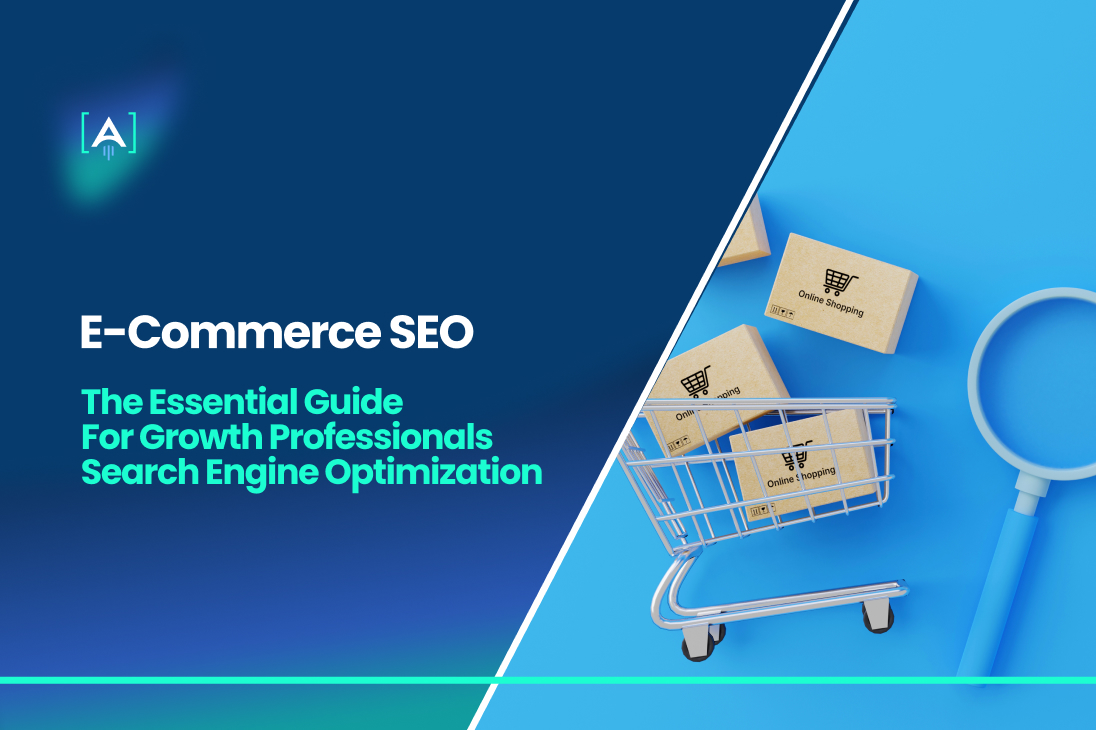The e-commerce landscape is highly competitive, making it crucial for startups to maintain a driven edge in the market.
This comprehensive guide on e-commerce SEO is designed to provide the necessary knowledge and insights to help startup founders navigate the complex world of search engine optimization and achieve success.
E-commerce SEO involves fine-tuning an online store to improve its ranking in Search Engine Results Pages (SERPs), increase visibility, and drive organic traffic, ultimately leading to higher sales. A robust SEO strategy is essential for achieving long-term success and sustainable growth.
It helps increase visibility, enhance credibility, and deliver a seamless user experience, all of which contribute to increased revenue.
By optimizing an e-commerce store for search engines, startup founders can tap into the immense potential of organic traffic, a reliable, cost-effective, and scalable source of customers.
This guide delves into the essential components of e-commerce SEO, providing practical knowledge and actionable insights tailored to the unique needs of startups.
By utilizing these insights, startups can establish a strong foundation for their online commerce ventures and drive their businesses toward significant growth and success.
The Importance of SEO for Startup Owners
Search Engine Optimization (SEO) is an essential digital marketing strategy that startup owners cannot afford to ignore. Here are some reasons why SEO is crucial for startup success:
Increased Visibility: By employing SEO strategies, your website can achieve higher rankings on search engine results pages (SERPs), which in turn boosts your online presence and draws a larger audience to your site.
Brand Credibility: A higher ranking in SERPs signifies that search engines view your website as a credible source of information, which boosts your brand credibility and instills trust in potential customers.
Cost-Effective: Compared to other marketing strategies, SEO is relatively cost-effective and can generate long-term results, providing startups with a solid foundation for growth.
Competitive Edge: Implementing SEO strategies gives your startup an advantage over competitors who neglect to prioritize SEO.
Targeted Traffic: SEO helps you target specific keywords and phrases relevant to your business, driving qualified traffic to your site and increasing the likelihood of conversion.
The Key Components of a Successful E-Commerce SEO Strategy
A successful e-commerce SEO strategy involves various key components that work together to increase website visibility, drive traffic, and improve conversion rates. These components include:
Keyword Research: Identifying the right keywords to target based on search volume, relevance, and competition.
On-page optimization: Ensuring website content is optimized for search engines, including using targeted keywords, meta tags, and alt tags.
Technical SEO: Ensuring website speed, mobile responsiveness, and site architecture are optimized for search engines.
Link-Building: Building high-quality backlinks to the e-commerce website from authoritative websites in the same industry.
Content Marketing: Creating high-quality content that is optimized for target keywords and shareable on social media platforms.
Analytics and Reporting: Regularly tracking and analyzing website traffic, user behavior, and conversion rates to measure the effectiveness of the e-commerce SEO strategy and make necessary adjustments.
In-depth Keyword Research for E-commerce

Keyword research is a crucial component of any successful e-commerce strategy. Conducting in-depth keyword research helps businesses identify the words and phrases that potential customers are searching for when looking for products or services online.
This information can be used to optimize website content, product listings, and ad campaigns to increase visibility and drive traffic to the e-commerce site.
In-depth keyword research involves analyzing search volume, competition, and relevance to ensure the keywords selected are highly targeted and likely to attract the right audience.
By investing time and resources into thorough keyword research, startups can gain a competitive edge in the crowded e-commerce landscape and improve their chances of success.
Understanding Buyer Intent and Targeting Long-Tail Keywords
When it comes to in-depth keyword research for e-commerce, understanding buyer intent is vital for targeting the right audience and driving conversions.
By analyzing the keywords and phrases that potential customers use in their search queries, businesses can gain insights into their motivations and needs and tailor their content to match their intent.
Long-tail keywords, in particular, can be highly effective for e-commerce businesses as they are more specific and targeted and often have a higher conversion rate.
For example, a customer searching for “mobile app development” may be at the initial stage of their buying journey, but a customer searching for the “best mobile app development agency near me” is likely more ready to make a purchase.
By targeting long-tail keywords that match the search intent of their target audience, e-commerce businesses can improve their chances of reaching the right customers and driving conversions.
Various Tools for Efficient Keyword Research
Starting an e-commerce business can seem overwhelming, but fortunately, there are several tools available to make the process easier.
The following tools can help businesses conduct efficient and comprehensive keyword research:
Google Keyword Planner
Google Keyword Planner is an essential tool for anyone interested in keyword research. It provides insights into keyword popularity, competition, and trends that can help optimize website content and drive targeted traffic.
With the ability to generate new keyword ideas and estimate their search volume, Google Keyword Planner is a powerful resource for developing effective SEO strategies.
Amazon Autosuggest
Amazon Autosuggest is a unique keyword research tool that can help businesses optimize their Amazon product listings.
It provides suggestions based on what people are searching for on Amazon, allowing sellers to identify popular keywords and phrases to include in their product titles and descriptions.
This can significantly improve the visibility of their products on the platform and increase sales.
Ahrefs
Ahrefs is an all-in-one SEO tool that includes a powerful keyword research feature. It allows users to analyze their competitors’ organic search traffic and identify the keywords they are ranking for.
This information can help businesses develop a more effective SEO strategy, optimize their content, and drive more targeted traffic to their website.
Ubersuggest
Ubersuggest is a free keyword research tool that can help businesses identify new keyword opportunities and analyze their competitors’ SEO strategies.
It provides detailed insights into keyword search volume, competition, and difficulty, as well as suggestions for related keywords and phrases.
With its user-friendly interface and powerful features, Ubersuggest is an excellent resource for anyone looking to improve their website’s search engine rankings.
Answer the Public
Answer the Public is a unique keyword research tool that provides insight into the questions people are asking online.
By generating a list of questions related to a particular keyword, businesses can identify topics for blog posts, articles, and other content that address their audience’s specific interests and concerns.
This can help improve website traffic and engagement, as well as establish the business as a thought leader in the industry.
Analyzing and Selecting the Best Keywords

Analyzing and selecting the best keywords for e-commerce is crucial for driving traffic and increasing sales.
This process involves researching and evaluating potential keywords based on relevance, search volume, competition, and conversion potential.
It also involves using tools like Google Keyword Planner, Ahrefs, or SEMrush, to gather data and insights on keyword performance. By analyzing and selecting the best keywords, you can create content that targets the specific needs of potential customers and drives traffic to your e-commerce site.
For example, if you are building a new fitness app, you may want to target keywords like “workout tracking app,” “personalized exercise plans,” or “fitness challenges for weight loss.”
These keywords are likely to attract highly targeted traffic and increase the chances of converting potential customers into paying customers.
The Role of Competitor Analysis in Keyword Research
Competitor analysis plays a critical role in e-commerce keyword research. By analyzing the keywords that competitors are targeting, businesses can gain insights into what is working in their industry and identify opportunities for improvement.
Competitor analysis can also help businesses identify gaps in the market where they can target keywords that their competitors may have overlooked.
For example, if a competitor is targeting broad keywords like “sneakers,” an e-commerce business could differentiate itself by targeting a long-tail keyword like “vegan sneakers” or “sustainable sneakers.”
By conducting thorough competitor analysis, e-commerce businesses can create a target keyword strategy that sets them apart from the competition and drives more qualified traffic to their website.
The Art of Site Architecture and Organization

The success of an e-commerce website depends on several factors, and one of the most critical ones is its site architecture and organization. A well-structured website not only helps search engines understand your content but also ensures that users can find what they’re looking for quickly and easily.
The three important aspects of site architecture in e-commerce SEO are: designing a simple, scalable, and user-friendly structure, implementing breadcrumbs for seamless navigation, and following URL structure best practices.
Designing a Simple, Scalable, and User-Friendly Site Structure
A clear and concise site structure is essential for both search engines and users.
E-commerce sites should aim for a hierarchy that makes sense and is easily navigable, with main categories at the top, followed by subcategories and product pages.
A simple and scalable structure allows for easy expansion as the website grows and new products are added.
Take, for example, Amazon.com, which has a clear and organized site structure with categories like Electronics, Books, and Home & Kitchen, followed by subcategories like Computers & Accessories and Cookware. This makes it easy for users to find what they’re looking for and for search engines to understand the website’s content.
To design a simple, scalable, and user-friendly site structure, it’s important to consider the user’s journey through the website.
Start with the main categories that represent the broadest sections of your product offerings, followed by subcategories that narrow down to specific product types. Each subcategory should contain a limited number of product pages, ensuring that users can easily find what they’re looking for without being overwhelmed by too many options.
A search bar should also be easily accessible from every page, allowing users to quickly find products without having to navigate through multiple pages.
By designing a site structure that is intuitive and easy to navigate, businesses can improve their user engagement and ultimately boost their sales.
Implementing Breadcrumbs for Seamless Navigation

Breadcrumbs are an effective way to enhance the navigation experience of your website. They provide a visual cue to the user, indicating their location on the website and allowing them to easily backtrack or move to a higher-level category.
For example, if a user is browsing through a clothing store’s website and selects a specific product, the breadcrumb trail would show the user the product category, such as men’s shirts, allowing them to quickly return to the category page.
In addition, implementing breadcrumbs can improve the SEO of your e-commerce site. Search engines use breadcrumbs to understand the structure of your site, which can help them determine the relevance of your content to specific search queries.
Overall, breadcrumbs are an essential navigational tool that improves the user experience and can potentially boost the visibility of your e-commerce site in search results.
URL Structure Best Practices
URL structure plays an important role in improving the search engine optimization (SEO) of an e-commerce website. One of the best practices for creating effective URLs is to keep them concise and descriptive.
A well-structured URL should provide a clear indication of what the page is about, making it easy for both search engines and users to understand the content.
For example, consider an e-commerce site that sells shoes, and a user is searching for a particular brand of running shoes. An effective URL for the SEO for e-commerce product pages would be “www.example.com/running-shoes/brand-name,” as it includes relevant keywords and clearly indicates the type of product and brand being sold.
This makes it easier for the search engine to identify the page’s relevance to the user’s query, improving the chances of the website appearing higher in the search results.
Following URL structure best practices can help improve the website’s overall SEO and make it easier for users to navigate through the site.
Technical SEO for E-commerce Websites

In today’s digital world, e-commerce websites are an essential tool for businesses to reach a global audience and increase their revenue. However, just having an online store is not enough to succeed in the highly competitive e-commerce market.
A well-designed website with a great user experience and optimized technical SEO is essential for online success. Here are some critical technical SEO aspects that e-commerce website owners need to consider:
Mobile Optimization and the Importance of Site Speed
Mobile optimization and site speed are crucial technical SEO factors for e-commerce websites. With the majority of users accessing online stores through mobile devices, it’s imperative to have a mobile-friendly website that loads quickly.
A slow-loading website might lead to a high bounce rate, resulting in lost sales and revenue. Therefore, optimizing your website for mobile devices and ensuring fast loading speeds is essential for a successful e-commerce website.
Dealing with Faceted Navigation and Other Common Technical Issues
Faceted navigation and other technical issues, such as duplicate content and broken links, can harm your e-commerce website’s search engine rankings.
Faceted navigation can create duplicate content issues, which can confuse search engines and harm your site’s user experience. So make a rule to have a clear faceted navigation structure and avoid common technical issues that can harm your website’s SEO.
Secure Your Site with HTTPS
With cybersecurity threats on the rise, it’s essential to secure your e-commerce website with HTTPS. HTTPS not only secures your website and protects your customers’ sensitive information but also enhances your website’s trust and credibility with search engines.
Moreover, Google now prioritizes websites with HTTPS, making it an important factor in improving your website’s search engine rankings.
Sitemap Submission and Monitoring Through Google Search Console
Submitting a sitemap to Google Search Console and regularly monitoring it is a critical technical SEO task for e-commerce websites.
A sitemap helps search engines understand your website’s structure, making it easier for them to crawl and index your pages.
Regularly monitoring your sitemap through Google Search Console can help you identify any crawl errors, duplicate content, or broken links, allowing you to fix them quickly and improve your website’s search engine rankings.
Image Optimization for Improved Site Performance

Optimizing your e-commerce website’s images is critical for improving site performance and user experience.
Large images can slow down your website’s loading speed, leading to a high bounce rate and lost sales.
Thus, always optimize your images by compressing them, reducing their file size, and using descriptive alt text to help search engines understand their content.
Duplicate Content and Canonicalization
Duplicate content is a common technical SEO issue that can harm your e-commerce website’s search engine rankings. Duplicate content can arise due to product descriptions, category pages, or other content appearing on multiple pages.
Canonicalization is the process of indicating to search engines which version of the content is the original and should be indexed, helping to avoid any duplicate content issues.
Therefore, implementing canonical tags on your e-commerce website is essential for improving your search engine rankings and ensuring a better user experience.
On-Page SEO Optimization for E-commerce

Establishing a strong online presence is essential for any business to succeed. This is especially true for e-commerce businesses, where the competition is fierce, and customers have endless options at their fingertips. To stand out and drive sales, having an effective on-page SEO strategy is crucial.
Here are five important strategies to improve your e-commerce website’s on-page SEO.
Crafting Unique Product and Category Descriptions
Unique and well-crafted product and category descriptions are essential for e-commerce websites. Unique descriptions not only make your website stand out from the competition but also help search engines understand the content of your website.
Well-written descriptions should provide a detailed yet concise overview of the product, highlighting its features and benefits.
Additionally, unique descriptions can help avoid duplicate content issues that can negatively impact your website’s search engine ranking.
Title Tags, Meta Tags, and Meta Descriptions Best Practices
Title tags, meta tags, and meta descriptions are critical components of on-page SEO optimization.
Title tags should be descriptive and include relevant keywords, while meta tags should provide a brief description of the content on the page.
A meta description should be compelling and concise, encouraging users to click through to the page. It’s also important to avoid duplicate title tags and meta descriptions, as this can negatively affect your website’s search engine ranking.
Optimizing Images with Alt Text and Descriptive File Names
Images play a significant role in e-commerce websites, but they can also have an impact on your website’s search engine ranking.
To optimize your images for SEO, it’s essential to use descriptive file names and alt text that includes relevant keywords.
Images should be compressed for faster load times, which can also improve your website’s overall search engine ranking.
Utilizing Schema Markup for Rich Snippets and Better Visibility
Schema markup is a type of microdata that provides additional information to search engines about the content on your website.
Using schema markup can help improve your website’s visibility in search engine results by displaying rich snippets, such as star ratings and product prices.
Schema markup can also improve the user experience by providing more detailed information about your products and services.
Harnessing the Power of Latent Semantic Indexing (Lsi) Keywords
LSI keywords are related terms and phrases that are semantically linked to the primary keyword on a web page.
Including LSI keywords in your content may help search engines better understand the context and relevance of your content. This can lead to improved search engine ranking and more targeted traffic to your website.
However, it’s important to avoid overusing keywords, as this may have a negative impact on your website’s search engine ranking.
Content Marketing and Blogging for E-commerce SEO

Effective content marketing and blogging are essential for driving traffic to e-commerce websites and increasing sales.
By creating valuable and engaging content, businesses can attract potential customers, build trust and establish themselves as authorities in their respective industries.
Building Authority and Boosting Organic Search Visibility
Establishing authority requires creating high-quality and informative content that offers value to the target audience. This can include blog posts, videos, infographics, and more.
By consistently producing valuable content, businesses can establish themselves as thought leaders and increase their organic search visibility. It is also essential to focus on link-building by guest posting on relevant websites to increase your website’s authority in the eyes of search engines.
By building relationships with other industry experts and consistently producing high-quality content, businesses can establish themselves as trusted sources of information, drive traffic to their websites, and increase sales.
Keyword Research and Optimization for Blog Posts
Keyword research involves identifying the keywords and phrases that potential customers are using to search for information related to your business. This helps businesses understand their target audience’s needs and preferences and create content that is relevant and valuable to them.
Once you have identified the relevant keywords, optimizing your blog posts involves strategically placing those keywords in your content.
However, it is important to strike a balance between keyword optimization and creating quality content that engages and informs readers. Overusing keywords can lead to a poor user experience and potentially harm your website’s search engine ranking.
By conducting thorough keyword research and optimizing blog posts with relevant keywords, businesses may increase their visibility and attract more traffic to their website.
Addressing Customer Pain Points Through Informative and Engaging Content
Addressing customer pain points through informative and engaging content is a highly effective strategy for e-commerce businesses to attract and retain customers. By understanding the needs and pain points of their target audience, businesses can create content that addresses these concerns in a helpful and informative way.
This can include blog posts that answer common questions, how-to guides that provide step-by-step instructions, and videos that demonstrate product features and benefits.
By creating content that speaks directly to their target audience’s pain points, businesses can establish themselves as a trusted authority in their industry, build stronger relationships with their customers, and ultimately drive more sales.
In addition, by regularly updating their content to reflect changing trends and customer needs, businesses can stay relevant and competitive in a crowded online marketplace.
Strategic Link-Building for E-commerce Websites

Strategic link-building is an essential element of any successful e-commerce website’s digital marketing strategy.
Link-building involves creating relevant and high-quality links to your site from other reputable websites, which can boost your site’s search engine rankings and drive more traffic to your pages.
The key to effective link-building is to focus on building links that are not only high-quality but also relevant to your business and industry. By building links on websites that are related to your niche, you can increase the authority and relevance of your website in the eyes of search engines like Google, which can ultimately lead to higher search rankings and more traffic.
Strategic link-building can also help to establish your website as a thought leader in your industry and improve your brand’s reputation, ultimately leading to increased sales and revenue.
Understanding the Importance and Types of Backlinks
Backlinks are links from other websites that point to your site, and search engines consider them as a vote of confidence in your website’s credibility and authority.
The more high-quality backlinks your site has, the more probable it is to rank higher in search engine results pages. Backlinks are also important because they can drive traffic to your site from other websites, increasing your visibility and potential customer base.
However, it’s crucial to note that not all backlinks are created equal. Backlinks from low-quality, spammy websites can actually harm your site’s ranking. That is why it’s important to focus on building high-quality, relevant backlinks from authoritative and reputable websites in your industry.
There are different types of backlinks, and understanding them can help you develop a more effective link-building strategy. Here are some of the most prevalent types of backlinks:
- Natural backlinks: created naturally when other websites find your content valuable and link to it without any incentive or request from you.
- Editorial backlinks: placed within the content of a website by an editor or author. These links are typically more valuable because they’re considered to be a vote of confidence from the website’s content creator.
- Guest post backlinks: included within an article or blog post that you have written for another website. This type of link-building can be effective if you choose reputable sites that are relevant to your niche.
- Directory backlinks: obtained by submitting your website to online directories. These links are generally considered to be of lower quality, but they can still provide value if you choose reputable directories.
- Forum backlinks: acquired by engaging in online discussion forums and incorporating a link to your site in your forum signature. This type of link-building can be effective if you choose forums that are relevant to your niche and provide valuable information.
- Social media backlinks: received from social media platforms, such as Facebook, Twitter, and LinkedIn. While these links are typically nofollow, meaning they do not pass link juice, they can still provide value by driving traffic to your website.
- Image backlinks: obtained by creating and sharing high-quality images on your website and on image-sharing websites, such as Flickr and Instagram. These links can be effective if the images are relevant to your niche and provide value to users.
- Paid backlinks: received by paying other websites for a link to your site. While this type of link-building can be effective, it is important to choose reputable websites and to ensure that the links are not spammy or low-quality.
- Reciprocal backlinks: obtained by exchanging links with other websites. While this type of link-building can be effective, it is important to choose relevant websites and to ensure that the links are high-quality and not spammy.
By understanding the different types of backlinks, you can choose the ones that are most relevant and effective for your website and develop a link-building strategy that will help you improve your SEO efforts and drive more traffic to your site.
Techniques for Acquiring High-Quality Backlinks
Acquiring high-quality backlinks can be a challenging and time-consuming task, but it is necessary for any website looking to improve its online presence.
Here are five effective techniques for acquiring high-quality backlinks and improving your website’s ranking and visibility:
Resource Page Link-Building
One technique for acquiring high-quality backlinks is through resource page link-building. This involves identifying high-authority websites in your niche that have resource pages and reaching out to them to request the inclusion of your website as a valuable resource.
This can lead to not only a backlink but also referral traffic from the website.
Influencer Partnerships
Another technique is through influencer partnerships. This involves collaborating with influencers in your industry to create content that promotes your website or products.
Influencers have a loyal following, and their endorsement can lead to high-quality backlinks and increased visibility for your e-commerce website.
Broken Link-Building
The process of broken link-building entails finding non-functional links on websites that possess a high level of credibility and then reaching out to the website owner to suggest replacing the broken link with a link that directs to your own website.
This technique not only provides a high-quality backlink but also helps improve the user experience of the website.
Competitor Link Analysis
Competitor link analysis involves analyzing the backlink profile of your competitors to identify opportunities for acquiring high-quality backlinks.
This can include identifying websites that link to multiple competitors and reaching out to them to request the inclusion of your website as well.
Guest Posting
Guest posting involves writing and publishing articles on high-authority websites in your niche, with a link back to your e-commerce website in the author bio or within the content.
This technique can provide high-quality backlinks and assist in establishing your brand as a thought leader in your industry.
Press Mentions and Leveraging HARO for Backlinks

One effective strategy for link-building in e-commerce is to focus on press mentions and to leverage Help a Reporter Out (HARO) for backlinks.
Press mentions can come from a variety of sources, such as industry publications, news outlets, and blogs. By actively seeking out opportunities to be featured in these outlets, e-commerce websites can earn valuable backlinks that not only drive traffic to their site but also signal to search engines that their content is authoritative and trustworthy.
HARO is another powerful tool for securing backlinks. By subscribing to HARO and responding to relevant queries from journalists and bloggers, e-commerce websites can earn high-quality backlinks from reputable sources.
However, it’s important to ensure that any links earned through these tactics are relevant, high-quality, and aligned with the overall SEO marketing strategy of the e-commerce business.
Avoiding Pitfalls of Low-Quality Backlinking Services
Strategic link-building is a critical aspect of any successful e-commerce website. It helps to improve website authority and ranking, which leads to increased organic traffic and sales.
However, it is essential to avoid the pitfalls of low-quality backlinking services that can do more harm than good. Here are some key considerations to remember when building backlinks for your e-commerce site:
• Avoid purchasing links from low-quality, spammy websites. These links can negatively impact your site’s authority and ranking.
• Focus on building links from high-quality, authoritative websites in your industry. These links will provide more significant value and help to establish your site as an authoritative source.
• Use a variety of anchor text to avoid over-optimizing for specific keywords. This can also help to make your backlink profile look more natural to search engines.
• Try to build relationships with other websites and bloggers in your industry to naturally earn backlinks over time.
• Monitor your backlink profile on a regular basis and disavow any spammy or low-quality links that may have slipped through the cracks
Measuring and Analyzing E-commerce SEO Success

With the ever-increasing competition in the e-commerce industry, it’s important to have a solid SEO strategy in place to ensure that your online store is visible to potential customers.
However, simply having a strategy isn’t enough. You also need to measure and analyze your e-commerce SEO success to identify areas for improvement and continuously optimize your strategy.
Here are three essential ways to measure and analyze e-commerce SEO success:
Tracking Search Rankings, Organic Traffic, and Engagement Metrics
One of the most critical aspects of measuring e-commerce SEO success is tracking search rankings, organic traffic, and engagement metrics.
Search rankings provide insights into how visible your store is to potential customers, while organic traffic measures the number of visitors who arrive at your site through search engines.
Engagement metrics such as bounce rate, pages per session, or time on site provide insight into the quality of the traffic you’re receiving. By tracking these metrics over time, you may identify trends and make better data-driven decisions to improve your e-commerce SEO strategy.
Identifying Areas for Improvement and Making Data-Driven Decisions
Another essential aspect of measuring e-commerce SEO success is identifying areas for improvement and making data-driven decisions.
By analyzing data from search rankings, organic traffic, and engagement metrics, you can identify areas where your strategy is falling short and make data-driven decisions to improve it.
For instance, if your bounce rate is high, you may need to improve your site’s loading speed or make changes to your site’s layout and design to improve user experience.
Continuously Optimizing and Updating Your E-Commerce Seo Strategy
Measuring e-commerce SEO success isn’t a one-time task. It’s an ongoing process that requires continuous optimization and updating of your strategy.
By tracking metrics and making data-driven decisions, you can identify new opportunities to improve your strategy, such as targeting new keywords or improving your site’s mobile experience.
Continuously optimizing your e-commerce SEO strategy will help ensure that your store remains visible and competitive in the ever-changing e-commerce landscape.
Reaping the Long-Term Benefits of E-commerce SEO
E-commerce SEO has become a critical component of online business success. By focusing on enhancing user experience and expanding your online reach, you can drive more traffic to your website and increase conversions.
Additionally, by building a strong foundation for sustainable business growth, you can reap long-term benefits that will continue to pay off for years to come.
Remember, the key to successful E-commerce SEO is not just about short-term gains but about investing in your business’s future by creating a user-friendly website and optimizing your online presence.
By doing so, you can stay ahead of the competition, meet your customers’ needs, and achieve your business goals.

